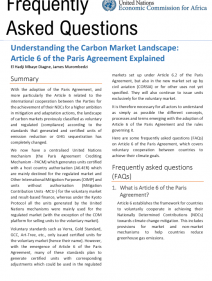With the adoption of the Paris Agreement, and more particularly the Article 6 related to the international cooperation between the Parties for the achievement of their NDCs for a higher ambition in mitigation and adaptation actions, the landscape of carbon markets previously classified as voluntary and regulated (compliance) according to the standards that generated and certified units of emission reduction or GHG sequestration has completely changed. Voluntary standards such as Verra, Gold Standard, GCC, Art-Tree, etc., only issued certified units for the voluntary market. However, with the emergence of Article 6 of the Paris Agreement, many of these standards plan to generate certified units with corresponding adjustments which could be used in the regulated markets set up under Article 6.2 of the Paris Agreement, but also in the new market set up by civil aviation (CORSIA) or for other uses not yet specified. They will also continue to issue units exclusively for the voluntary market. It is therefore necessary for all actors to understand as simply as possible the different concepts, processes and terms emerging with the adoption of Article 6 of the Paris Agreement and the rules governing it. Here are some frequently asked questions (FAQs) on Article 6 of the Paris Agreement, which covers voluntary cooperation between countries to achieve their climate goals.
Share this:
Frequently asked questions: Article 6 of the Paris agreement explained
Release Date:
12 novembre, 2024
© United Nations Economic Commission for Africa

